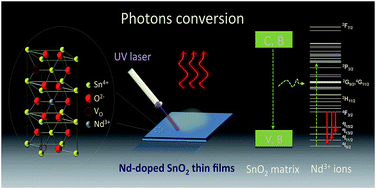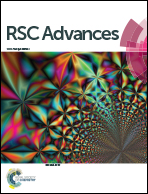Insight into photon conversion of Nd3+ doped low temperature grown p and n type tin oxide thin films†
Abstract
The synthesis of multifunctional high-quality oxide thin films is a major current research challenge given their potential applications. Herein, we report on p and n type tin oxides thin films as functional TCOs with photon management properties through doping with Nd3+ rare earth ions. We show that the structure, composition, carrier transport and optical properties of the sputtered Nd:SnOx films can be easily tuned by simply varying the Ar/O2 gas flow ratio (R) during the deposition step. The increase of the oxygen content leads to drastic changes of the material properties from p-type SnO to n-type SnO2. Furthermore, all Nd:SnOx films are found to be highly conductive with resistivities as low as 1 × 10−3 Ω cm−1 and carrier mobilities up to 129 cm2 V−1 s−1. Thanks to deep XPS and NEXAFS spectroscopies, we gained insight into the coordination and oxidation degrees of the elements within the matrices. The insertion and optical activation of the incorporated Nd3+ ions have been successfully achieved in both matrices. As a consequence, strong NIR luminescence lines, typical of Nd3+ ions, were recorded under UV laser excitation. We experimentally show that the efficient Nd3+ photoluminescence in the near infrared region originates from efficient sensitization from the host matrix, through energy transfer. We found that the SnO2 host matrix provides more efficient sensitization of Nd3+ as compared to the SnO matrix. An energy transfer mechanism is proposed to explain the observed behaviour.


 Please wait while we load your content...
Please wait while we load your content...